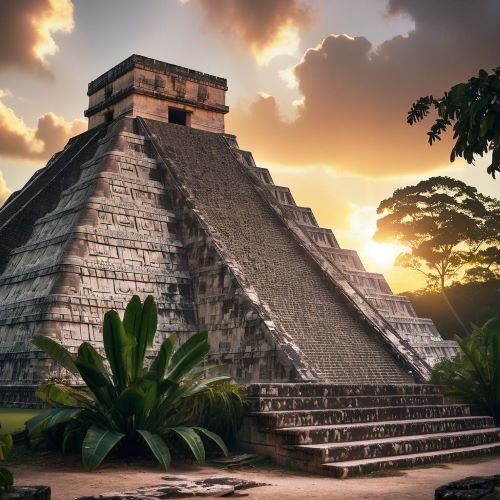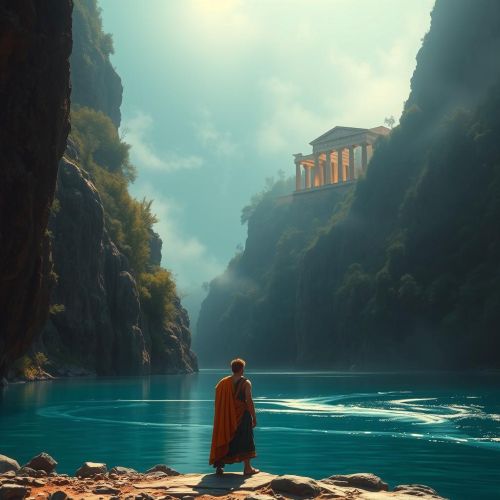Cenote Sagrado : Gateway to the Underworld
At a glance
| Description | |
|---|---|
| Mythology | Mayan Mythology |
| Country | Mexico |
| Closest airport | Mérida International Airport (MID) |
| Type | Natural |
| Accessibility | 08/10 |
Introduction
Deep within the ancient city of Chichén Itzá in Mexico’s Yucatán Peninsula lies the Cenote Sagrado, or Sacred Cenote. Unlike many other cenotes that provided drinking water, this natural sinkhole became one of the most important ceremonial sites for the Maya civilization. Measuring around 60 meters in diameter and plunging over 20 meters deep, its emerald waters once received offerings of jade, gold, and even human lives. To the Maya, it was far more than a natural landmark—it was a sacred passage between the world of the living and the underworld. Today, the Cenote Sagrado is one of the most visited sites in Chichén Itzá, drawing travelers fascinated by history, archaeology, and ancient spirituality.
Connection with Mythology
In Maya belief, cenotes were sacred wells that bridged the earthly plane and the watery depths of Xibalba, the underworld. The Cenote Sagrado was dedicated primarily to Chaac, the god of rain and fertility, whose favor was vital in the often harsh climate of the Yucatán. During periods of drought, rituals were performed at the cenote, with offerings that included precious ornaments, incense, pottery, and sometimes human lives. Archaeological studies reveal that many of the sacrificial victims were young men and children, chosen as messengers to the gods.
The presence of a raised ceremonial causeway, the sacbé, linking the Temple of Kukulcán to the Cenote Sagrado highlights its significance in religious processions. This sacred road symbolically connected the world of humans with the gods who resided beyond the cenote’s depths. For the Maya, every act at the Sacred Cenote was a dialogue with the divine, reinforcing its role as a spiritual gateway.
Ways to Get There
Reaching the Cenote Sagrado is straightforward, as it lies within the Chichén Itzá archaeological zone, a UNESCO World Heritage Site. From Cancún, the drive takes about two and a half hours along Highway 180, while from Mérida it is roughly two hours. Travelers can choose between renting a car, taking ADO buses, or booking guided tours, which often include both transport and expert commentary.
Once at Chichén Itzá, the cenote is a short walk of about 300 meters from the main plaza, accessible via the historic sacbé. The path itself is worth exploring, as it recreates the ancient ceremonial approach once used by the Maya. Visitors are advised to arrive early in the morning, not only to avoid the midday crowds but also to experience the site in the softer light that enhances its atmosphere.
What to Look For
The Cenote Sagrado is striking in its scale and setting. Its vertical limestone walls drop dramatically into still, green waters that shimmer under the Yucatán sun. Unlike many cenotes in the region, swimming here is prohibited out of respect for its sacred history and to protect ongoing preservation efforts.
Visitors will notice the remnants of the sacbé that once guided ceremonial processions. The site also features interpretive panels that describe the rituals once performed here and the artifacts discovered during excavations. Many of these items—including jade figurines, obsidian blades, gold ornaments, and incense—can be seen in museums such as the National Museum of Anthropology in Mexico City and Harvard’s Peabody Museum, which houses finds from Edward H. Thompson’s dredging of the cenote in the early 20th century.
Standing at the rim, one can imagine the solemn rituals that once unfolded here, the chants of priests echoing through the jungle as offerings were cast into the waters below.
Need a place to stay? Book your hotel room now!
Importance in cultural history
The Cenote Sagrado plays a central role in understanding Maya religion, politics, and society. For the Maya, water was not only a necessity but also a divine element, and cenotes embodied that sacred connection. Spanish chroniclers like Diego de Landa recorded accounts of human sacrifices at the Sacred Cenote, confirming its role as a ritual hub during the Postclassic period.
Archaeological exploration has revealed thousands of objects deliberately placed in its depths, reflecting both the wealth of Chichén Itzá and the reach of its trade networks. The discovery of metals such as copper and gold, sourced from distant regions of Mesoamerica, demonstrates the wide exchange systems of the time. The presence of human remains, some showing evidence of ritual violence, underscores the cenote’s role as a stage for both devotion and sacrifice.
The cenote also reflects the Maya’s cosmological worldview. Its placement within Chichén Itzá’s sacred landscape, directly linked to the Temple of Kukulcán, symbolizes a deliberate alignment between earth, sky, and underworld. Today, the Cenote Sagrado remains a touchstone for scholars and visitors alike, providing insight into the complexity of Maya belief systems and their relationship with the natural world.
Best time to travel
The Yucatán Peninsula has a tropical climate, making the timing of your visit an important consideration. The best months to explore Chichén Itzá and the Cenote Sagrado are from November to April, when the weather is dry and temperatures are more comfortable, ranging between 22°C and 30°C. This period also offers clearer skies for photography and more pleasant walking conditions across the sprawling site.
The rainy season, from June to October, brings high humidity and frequent downpours, occasionally accompanied by hurricanes. While the site remains open, the experience can be less enjoyable due to slippery paths and heavy heat. To make the most of your visit, plan to arrive at the opening time of 8:00 AM. Not only will you avoid the heaviest crowds from midday tour groups, but you will also experience the cenote in relative tranquility, which enhances its spiritual and historical resonance.
Source
Rosado van der Gracht, C. (2025, August 18). The Sacred Cenote of Chichén Itzá: A Portal to the Maya Underworld. Yucatán Magazine. https://yucatanmagazine.com/sacred-cenote-chichen-itza/
Wikipedia contributors. (2025). Sacred Cenote. Wikipedia. https://en.wikipedia.org/wiki/Sacred_Cenote
Giunta, J. (2024, September 10). Exploring the Mystical Cenotes of the Maya: A Cultural Odyssey. Ancientpedia. https://ancientpedia.com/exploring-the-mystical-cenotes-of-the-maya-a-cultural-odyssey/
Price, T., Tiesler, V., & Freiwald, C. (2019). Place of origin of the sacrificial victims in the sacred Cenote, Chichén Itzá, Mexico. https://onlinelibrary.wiley.com/doi/abs/10.1002/ajpa.23879
The Sacred Cenote – Chichen Itza. (n.d.). https://www.chichenitza.com/cenote
0. (n.d.). Cenote History & Maya Mythology. https://rigothecenoteguide.com/cenote-history-and-maya-mythology
Sacred Cenote | Maya Ruins of Chichén Itzá. (n.d.). https://mayaruins.com/chichen/SacredCenote.html
Frequently Asked Questions
Lorem ipsum dolor sit amet, consectetur adipiscing?
Lorem ipsum dolor sit amet, consectetur adipiscing elit. Praesent convallis vestibulum justo, ac tincidunt nunc vehicula quis. Nullam id dolor quis orci malesuada feugiat. Curabitur aliquet libero at urna ullamcorper, ac ultricies nulla dapibus.
Lorem ipsum dolor sit amet, consectetur adipiscing?
Lorem ipsum dolor sit amet, consectetur adipiscing elit. Praesent convallis vestibulum justo, ac tincidunt nunc vehicula quis. Nullam id dolor quis orci malesuada feugiat. Curabitur aliquet libero at urna ullamcorper, ac ultricies nulla dapibus.
Lorem ipsum dolor sit amet, consectetur adipiscing?
Lorem ipsum dolor sit amet, consectetur adipiscing elit. Praesent convallis vestibulum justo, ac tincidunt nunc vehicula quis. Nullam id dolor quis orci malesuada feugiat. Curabitur aliquet libero at urna ullamcorper, ac ultricies nulla dapibus.
Lorem ipsum dolor sit amet, consectetur adipiscing?
Lorem ipsum dolor sit amet, consectetur adipiscing elit. Praesent convallis vestibulum justo, ac tincidunt nunc vehicula quis. Nullam id dolor quis orci malesuada feugiat. Curabitur aliquet libero at urna ullamcorper, ac ultricies nulla dapibus.
Lorem ipsum dolor sit amet, consectetur adipiscing?
Lorem ipsum dolor sit amet, consectetur adipiscing elit. Praesent convallis vestibulum justo, ac tincidunt nunc vehicula quis. Nullam id dolor quis orci malesuada feugiat. Curabitur aliquet libero at urna ullamcorper, ac ultricies nulla dapibus.









